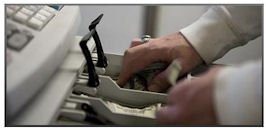|

The Increase of Internal Fraud
Over Time
When it comes
to shrink, the first thing
that comes to mind for many is
shoplifting and organized
retail crime. As loss prevention
professionals, though,
we understand that this just
isn’t the case. Every year
the National Retail Security
Survey reminds us that
shrink is increasing, and that
44-47 percent of that
shrink comes from internal
fraud. Add to this training
and clerical errors and it
becomes clear that well over
50 percent of all shrink comes
from inside the
organization. But why does this
number keep growing?
 First,
let us remove clerical errors
from the equation (after
all we are human), and focus on
the actual fraud taking
place. With total shrink
increasing annually, and
internal fraud increasing with
it, there has to be
something going on here that is
causing employees to
take more and more each year.
One of the theories behind
this is a fairly simple economic
factor, inflation.
Items are becoming more
expensive, and in many cases
smaller. This means that
employees can take fewer items,
but have a large impact over
time. This theory is fairly
logical, but it doesn’t fit all
areas of retail. First,
let us remove clerical errors
from the equation (after
all we are human), and focus on
the actual fraud taking
place. With total shrink
increasing annually, and
internal fraud increasing with
it, there has to be
something going on here that is
causing employees to
take more and more each year.
One of the theories behind
this is a fairly simple economic
factor, inflation.
Items are becoming more
expensive, and in many cases
smaller. This means that
employees can take fewer items,
but have a large impact over
time. This theory is fairly
logical, but it doesn’t fit all
areas of retail.
Another theory that goes along
with inflation involves
employee salary. The thought
process behind this theory
is that retail associate’s pay
increases do not reflect
the increase in inflation. In
other words their pay goes
up, but not as much as it
“should have.” In the area of
organizational behavior there is
a workplace deviance
referred to as property
deviance. Property deviance
involves an employee who feels
as though they are not
being paid fairly, and so they
either steal or damage
items from their employers (nine
times out of 10 they go
the stealing route). This theory
makes sense, but there
is more to it.
To go along with property
deviance there is something
referred to as graduation, or
escalation. This is when
employees start to take more and
more over time because
they have not been caught and
feel as though they can.
This act has been studied by
many, and has been
confirmed in factory and office
setting, but never for
retail. We felt as though this
needed to change because
it’s one thing to make decisions
based on a theory and
another to make decision based
on a proven theory. We
set out to try and confirm the
theory of escalation
using statistics from our own
clients, and put our
results in an executive white
paper.
|